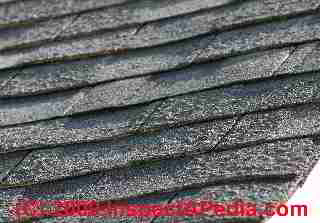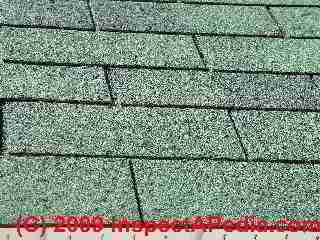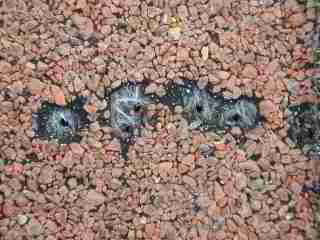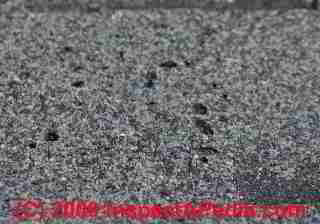 Causes of Asphalt Shingle Blister Rash
Causes of Asphalt Shingle Blister Rash
Cause of
Asphalt Roof Shingle Blistering
- POST a QUESTION or COMMENT about blistering damage on roof shingles.
This article explains the causes of asphalt roof shingle blistering or "blister rash" on asphalt roofing, citing expert sources & authoritative research as well as field inspection and forensic investigation of blistered asphalt shingles. This article sorts out speculative opinion from more soundly-based research into the causes & effects of blister formation on asphalt roof shingles and on some roll roofing products.
InspectAPedia tolerates no conflicts of interest. We have no relationship with advertisers, products, or services discussed at this website.
- Daniel Friedman, Publisher/Editor/Author - See WHO ARE WE?
Causes of Shingle Blisters & Blister Rash on Asphalt Roof Products

Asphalt Shingle Blister Rash - is a manufacturing artifact caused by trapped moisture vapor or solvent gas bubbles. The evidence & the science are explained here.
Rash blisters on asphalt shingles result from the manufacturing process, (and may be cosmetic or possibly a more serious defect) which are sometimes mistaken for hail damage or other types of asphalt shingle roof wear or damage indicators.
Note: separately at BLISTERS on ASPHALT SHINGLES we discuss the identification of asphalt shingle blister rash, how it is distinguished from other types of roof damage including hail damage, and we review the effects of blistered shingles on remaining roof life.
The most likely causes of asphalt shingle blisters or "blister rash" visible in product right from the factory is the expansion in gas form of either moisture trapped in the shingle substrate at the time of manufacture or gases from volatile organics or resins used in the shingle construction. Either of these can produce trapped gas bubbles as the shingles are exposed to high temperatures during production.
Shingle blisters might be caused as well by excessive use of roofing mastic or additional adhesives that are applied during or after roof installation. A warning to this effect issued by GAF Materials Corporation is found at WIND DAMAGE to ROOFS.
In such a case of adhesive-caused blister rash, the blisters ought to appear in a pattern that matches the blobs of adhesive, not in the regular pattern such as shown in our photo at above left (click to enlarge).
Role of Attic Temperature & Moisture Levels in Asphalt Shingle Blister Rash?

Other somewhat more mixed or speculative theories blame asphalt shingle blister rash on attic ventilation or attic temperatures beneath installed roof. Although some sources including a State Farm Insurance Company PDF (statefarm.com/_pdf/roofing-composition-shingle.pdf) and a roofing website (pattoncontracting.com/roofing-blistering.htm) am not sure they are entirely correct.
Blister rash can be found on new asphalt shingle product that has never been rained-on - shingles right out of the factory-wrapped bundle.
That an asphalt shingle blister can by mechanical damage or mere weather exposure convert to exposed shingle substrate and even ultimately to shingle damage is suggested by our photo at left.
Experts place the underlying cause on moisture content or volatile solvent gas content of the material upon which the shingle is built (in the factory), if a felt or resin-filled fiberglass substrate is inadequately moisture-resistant and is wet at the time of manufacture or if there were inadequately cured resins or binders that then might outgas during manufacture those are the most likely sources of blistering.
It seems to me that although on the roof shingles can become quite hot, they probably do not reach the same temperatures as during manufacture. For blister rash to be caused by moisture after the roof is installed we would have to argue that the shingle resins or binders are soft enough that combined with moisture or VOC presence tiny bubbles of gas form within a near-liquid material. In my view that seems less likely than such formations during shingle manufacture.
Diagnostic in the assertion that field conditions contribute to or cause blistering would be to find credible reports that blister rash appeared on asphalt shingles after installation, with some compelling evidence that it was not present when installed.
I would also expect field-caused asphalt shingle blister rash to be progressive in appearance and for its occurrence to correlate with a sequence of weather conditions such as rain, temperature variations, sun exposure, etc. (Beware that often a pre-existing condition is seen as "new" or "just occurred" when in truth it was always there but simply was not noticed previously.)
Field Investigation of Asphalt Shingle Blister Rash Patterns vs Proposed Causes

If asphalt shingle blistering were principally caused by a hot attic we'd expect to see a correlation with finding blisters and bad attic venting and moisture exposure and documented proof that the blisters were not present at time of roof installation.
I suspect that the reason attic temperatures entered into the urban lore on asphalt shingle blister rash is that experts have cited trapped moisture and heat as an original cause of blister rash - one can place this effect in the manufacturing process well before in field service.
That is, blistered shingles are evident in new product right out of the bundle not just on installed roofs. Furthermore blisters on installed asphalt shingle roofs that I have personally inspected have not once been found in patterns that correlated to attic moisture exit points (roof sheathing butt joints, roof penetrations for example) nor to sun exposure of individual roof slopes, nor even to the detailed thermal stress patterns in individual shingles documented by Cash & Kan.
Rather I see blistered shingles from individual bundles of shingles that may be installed rather uniformly over a large roof area on various slopes, or depending on the product delivered, installed in patterns consistent with how shingles were pulled and nailed from individual shingle bundles during roof installation - in some cases leaving a blistered shingle immediately next to a smooth un-blistered shingle and forming a strong argument against in-situ causation of the blistering.
The most scientific study of asphalt shingle blistering I've found was by Cash & Kan (cited below). Cash & Kan found that shingle blisters are a manufacturing defect traced to either moisture in the shingle substrate (damp felt or damp fiberglass mat) and/or inadequately cured resin in the shingle base during manufacture.
Cash & Kan's findings in their cross-sectional analysis of blistered roof shingles were quite consistent with my own forensic study of paint blistering (found at PAINT FAILURE LAB ANALYSIS) where cross-sectional microscopic analysis of blisters in a pinated [sic] surface showed physical evidence consistent with blisters formed in still-pliable materials as heat caused volatile gases to produce small bubbles in the material substrate.
Quoting Cash & Kan:
We obtained one regular radiographic (x-ray) image and several axial images (vertical sections) through each of the samples.
As expected, some of the axial images of the blistered shingle clearly show the blisters extending through the top coating (Fig. 10).
The axial images of the unexposed and un blistered shingle show small bubbles in the coating at elevation of the
glass fiber felt (Fig. 11), suggesting the mat was moist or the mat binding resin was incompletely cured when the shingles were
manufactured.
In further lab testing of asphalt shingle standards and materials for blister resistance (Behavior of Heating - ASTM D228, SGH Blistering Test, and Bubbling Test, European Standard prEN 544) in only the third test, the European Standard prEN 544 were Cash et als able to duplicate the same shingle blistering pattern as seen in field-installed products.
Quoting McNulty
ARMA has defined blisters as “hollow raised areas of variable size and shape which develop on the exposed surface of asphalt roofing
upon exposure to the weather.” Blisters are normally of two types—small rash blisters and large blisters in which the entire thickness of the coating asphalt is raised from the felt and contributes to the deterioration of the roofing.
The evidence to date
indicates that blisters are formed as a result of the behavior of entrapped air and moisture when subject to certain heat or
temperature conditions. When excess amounts of solventbased roofing adhesives are used, the shingle will absorb the solvent and the
process is the same as for moist air. Dry air expands, on warming, in direct proportion to the increase in temperature.
Water, on
the other hand, expands approximately 1,244 times in changing from a liquid to a vapor. Thus, if a shingle absorbs moisture which is
trapped in the small voids in the coat ing asphalt, this air will, at roof temperatures, expand and form blisters.
Blister
formation can be minimized by ensuring the use of dry felts, saturating to the maximum possible without creating “wet spots” of
saturant, ensuring the finished product is stored in a dry environment, and by minimizing moist air accumulation in attic areas by
proper venting. The use of recommended amounts of roofing cement for tabbing and low slope shingle application is, of course, a
necessity.
Rash blisters generally will not vent and should not pose a threat to the integrity of the roof. Large blisters (greater
than 6.5mm in diameter) will, in all likelihood, vent, and roofs in this condition should be replaced.
In my (DF) OPINION, even here in McNulty's comments I suspect there is a mix of good science, authoritative source, and speculative opinions. For example his comment about attic moisture and roof ventilation.
The rate of moisture movement out through the roof structure of a humid or even wet attic is anything but uniform, with more water moving at plywood butt joints and penetrations than through the field of plywood 4x8' solid segments. So we ought to see moisture damage on the roof surface in a pattern that maps moisture migration openings.
For blistering, we don't.
Back in 1986 in the Boston Journal of Light Construction conference we learned that far more air and moisture movement, perhaps more than 90% of it, occurs at material joints and penetrations than through the field of the material, be it 1/2" drywall or 1/2" thick plywood.
Here are three helpful references for asphalt shingle blister rash causation & research:
[1] Cash, Carl G., and Frank W. Kan. "Finite Element Analysis of Racked vs. Traditionally Applied Three Tab, Seal Tab, Strip Shingles, and Blister Tests for Asphalt-Glass Felt Shingles." ASTM SPECIAL TECHNICAL PUBLICATION 1349 (1999): 123-131.
[2] McNulty, Raymond A. "COMPOSITION, PERFORMANCE, FUNCTION, AND STANDARDS." Interface (2000). [http://www.rci-online.org/interface/2000-01-mcnulty.pdf]
[3] Petty, Stephen E. "Attic and Crawlspace Ventilation." Forensic Engineering: Damage Assessments for Residential and Commercial Structures (2013): 437.
Our complete set of references on asphalt shingle blistering can be found atReferences or Citations .
At BLISTERS on ASPHALT SHINGLES we discuss the identification of asphalt shingle blister rash, how it is distinguished from other types of roof damage including hail damage, and we review the effects of blistered shingles on remaining roof life.
Premature Asphalt Shingle Blistering or Cracking?
While indeed we have documented product failures involving asphalt shingle cracking, the above technical explanation suggesting that asphalt shingle blisters are principally a manufacturing artifact that should be visible from the time of delivery of the product leads us to watch with interest asphalt shingle roof failure claims, litigation, and class actions naming shingle blistering, such as currently cited for Atlas Chalet Shingle blistering and cracking failures as well as blistering claims for shingles made by CertainTeed, IKO and other asphalt shingle brands noted below.
Atlas Chalet shingles have been discontinued from production and are a subject of class action. Quoting:
"... customers complain of premature cracking and blistering, sometimes in as little as one year after installation." [2]
- [1] Atlas Roof Shingle Warranty Information: Contact information for Atlas Roofing and atlas roof shingle warranty claims form
Atlas Roofing Corporation Attn: Consumer Services 2564 Valley Road Meridian, Mississippi 39307 Website: www.atlasroofing.com
Atlas LIMITED SHINGLE WARRANTY [PDF] - retrieved 2020/03/24 original source: www.atlasroofing.com/Warranty
Atlas SIGNATURE SELECT SYSTEM WARRANTY BROCHURE [PDF] - retrieved 2020/03/24 original source: op. cit.
Atlas LIGHT COMMERCIAL & MULTI-FAMILY STEEP SLOPE WARRANTY GUIDE [PDF] (2019)
Warranty registration and warranty claims application information: www.atlasroofing.com/Warranty - [2] Atlas Chalet Roof Shingle Blister/ Crack Claims found at www.atlaschaletclaims.com
- [3] Certainteed Asphalt Roof Shingle blistering & damage class action settlement - see certainteedshinglesettlement.com/faq.cfm
- [4] IKO Asphalt Roof Shingles blistering & damage class action lawsuit - see www.iko.com/ and also http://www.seegerweiss.com/news/iko_organic_shingles_class_action_lawsuit and
- Barwin v IKO Industries Ltd., 2013 ONSC 3054, Divisional Court File No. 559/12, Date: 20130605 heard April 2,3 2013.
- [5] GAF Roof Warranty: a confusing consumer website cites "GAF shingles have blister lawsuit" at http://ny.mobdukta.pp.ua/k8H
- WARRANTIES for ROOF SHINGLES
We will continue to watch these and other sources for evidence (to be reported here) that asphalt shingle blisters (as opposed to cracking, granule loss, or other defects) develop after roof installation.
...
Reader Comments, Questions & Answers About The Article Above
Below you will find questions and answers previously posted on this page at its page bottom reader comment box.
Reader Q&A - also see RECOMMENDED ARTICLES & FAQs
Question: could hail damage to roof shingles lead to later shingle rash or shingle blisters?
Thank you for your web site and all the information you provide!!! I have done some research on hail damage and blistering.
I was wondering if it would be reasonable to suggest that hail damage [see HAIL DAMAGED SHINGLES & OTHER ROOF COVERINGS] could be a cause of blistering? Seems blistering requires some sort of initiating cause such as manufacture defect or moisture. And, appears some hail damage is quite small, only the removal of few granules and possible underlying asphalt leaving behind a small void. Could moisture then get absorbed into the shingle? And later cause blistering?
I have lived in both AZ and N. TX. Hail occurs more frequently in TX. And, roof in AZ undoubtedly get hotter than in N. TX. But I didn't find that blistering (of asphalt shingles) was much of a problem in AZ. The examples found seem to be in areas which are more prone to hail. So, this is pushing me to believe that hail could be causing the blistering in many cases. What do you think? - B.S.
Reply:
I have not thought about hail damage as causing blistering but you raise an interesting question about the possible causes of that shingle anomaly.
My OPINION has been that blistering or shingle rash starts as a manufacturing artifact, a bumpy shingle surface that is caused by the manufacturing process itself - perhaps the shingle granules are clustered or stuck together, or perhaps there are temperature variations that cause bubbles or just lumps in the asphalt on the shingle substrate to which the granules are applied. But I do not know - and I bet the manufacturers know exactly how this is happening.
There is no doubt that we see blistered or rashed shingles that come out of the bundle, new, from the factory in that condition. And manufacturers generally opine that it's a cosmetic only condition - a viewpoint with which I do not always agree.
But you raise the interesting question of whether or not hail impact could cause a more subtle damage to shingles that leads to a second type or source of shingle blistering.
That explanation doesn't match with the close-up examination I've made of some hail damaged roofs on which I saw that granules are dislodged or scoured off of the shingle surface. But I grant that an impact that leaves granules in place could have the more subtle effect you suggest: a loosening or opening of the granule surface to allow water and perhaps freezing impact on the shingle surface.
To investigate the question in a more credible and scholarly way would involve at least dissecting some hail impacted asphalt roof shingles. We'd cut the shingle in cross section and make microscopic examination of the cross section for visual evidence of changes in the material - as a start. Even more subtle effects of hail impact on the adhesive properties of the shingle surface, adhering granules to the asphalt substrate, could be present and would require a more technical, perhaps chemical analysis to observe.
Frankly I don't think the hail as previously un-recognized source of shingle blisters explanation sounds very likely. Conversely, there is sufficient (size, mass, velocity, angle of impact) hail damage to an asphalt shingle roof that was already blistered, I would expect the blisters to play a role in the subsequent hail damage or roof wear that would be observed.
But it's worth taking a closer look at your hypothesis by examining some representative shingles microscopically and by asking shingle manufacturers for their opinion. Let's pursue it. - Editor
...
Continue reading at BLISTERS on ASPHALT SHINGLES or select a topic from the closely-related articles below, or see the complete ARTICLE INDEX.
Or see these
Recommended Articles
- ASPHALT SHINGLE FAILURE TYPES
- ASPHALT SHINGLE LIFE / WEAR FACTORS
- ASPHALT SHINGLES on LOW SLOPE ROOFS
- GRANULE LOSS from SHINGLES
- SHINGLE HAIL DAMAGE vs SHINGLE BLISTER RASH
- SHINGLE HAIL DAMAGE REPLICATION
- SHINGLE HAIL DAMAGE CHALK MARKING CODES
- SHINGLE HAIL DAMAGE RESISTANT PRODUCTS
- WARRANTIES for ROOF SHINGLES
Suggested citation for this web page
ASPHALT SHINGLE BLISTER RASH CAUSE at InspectApedia.com - online encyclopedia of building & environmental inspection, testing, diagnosis, repair, & problem prevention advice.
Or see this
INDEX to RELATED ARTICLES: ARTICLE INDEX to BUILDING ROOFING
Or use the SEARCH BOX found below to Ask a Question or Search InspectApedia
Ask a Question or Search InspectApedia
Try the search box just below, or if you prefer, post a question or comment in the Comments box below and we will respond promptly.
Search the InspectApedia website
Note: appearance of your Comment below may be delayed: if your comment contains an image, photograph, web link, or text that looks to the software as if it might be a web link, your posting will appear after it has been approved by a moderator. Apologies for the delay.
Only one image can be added per comment but you can post as many comments, and therefore images, as you like.
You will not receive a notification when a response to your question has been posted.
Please bookmark this page to make it easy for you to check back for our response.
IF above you see "Comment Form is loading comments..." then COMMENT BOX - countable.ca / bawkbox.com IS NOT WORKING.
In any case you are welcome to send an email directly to us at InspectApedia.com at editor@inspectApedia.com
We'll reply to you directly. Please help us help you by noting, in your email, the URL of the InspectApedia page where you wanted to comment.
Citations & References
In addition to any citations in the article above, a full list is available on request.
- Cash, Carl G., and Frank W. Kan. "Finite Element Analysis of Racked vs. Traditionally Applied Three Tab, Seal Tab, Strip Shingles, and Blister Tests for Asphalt-Glass Felt Shingles." ASTM SPECIAL TECHNICAL PUBLICATION 1349 (1999): 123-131.
- McNulty, Raymond A. "COMPOSITION, PERFORMANCE, FUNCTION, AND STANDARDS." Interface (2000). [http://www.rci-online.org/interface/2000-01-mcnulty.pdf]
- Petty, Stephen E. "Attic and Crawlspace Ventilation." Forensic Engineering: Damage Assessments for Residential and Commercial Structures (2013): 437.
- Marcia Reid generously shared her photographs of IKO roof shingle blistering 4/8/2009. Ms. Reed lives in Saskatoon, Saskatchewan.
- Jim Todd, provided photographs and description of shingle blister rash on a four year old Atlas Chalet™ shingle roof. 9 July 2009.
- Low Slope Roofing, Manual of, 4th Ed., C.W. Griffin, Richard Fricklas,
McGraw-Hill Professional; 4 edition, 2006, ISBN-10: 007145828X, ISBN-13: 978-0071458283
- Roof failure causes in depth (and specific methods for avoiding them)
- Roof design fundamentals and flourishes, based on voluminous industry research and experience
- New technologies and materials -- using them safely and correctly
- Comprehensive coverage of all major roofing systems pecifications, inspection, and maintenance tools for roofing work
- Problems in Roofing Design, B. Harrison McCampbell, Butterworth Heineman, 1991 ISBN 0-7506-9162-X (available used)
- Roofing The Right Way, Steven Bolt, McGraw-Hill Professional; 3rd Ed (1996), ISBN-10: 0070066507, ISBN-13: 978-0070066502
- Smart Guide: Roofing: Step-by-Step Projects, Creative Homeowner (Ed), 2004, ISBN-10: 1580111491, ISBN-13: 978-1580111492
- Asphalt Roofing Residential Manual from ARMA the Asphalt Roofing Manufacturers Association Website https://www.asphaltroofing.org/product/residential-asphalt-roofing-manual/ ,
- Building Pathology, Deterioration, Diagnostics, and Intervention, Samuel Y. Harris, P.E., AIA, Esq., ISBN 0-471-33172-4, John Wiley & Sons, 2001 [General building science-DF] ISBN-10: 0471331724 ISBN-13: 978-0471331728
- Building Pathology: Principles and Practice, David Watt, Wiley-Blackwell; 2 edition (March 7, 2008) ISBN-10: 1405161035 ISBN-13: 978-1405161039
- Our recommended books about building & mechanical systems design, inspection, problem diagnosis, and repair, and about indoor environment and IAQ testing, diagnosis, and cleanup are at the InspectAPedia Bookstore. Also see our Book Reviews - InspectAPedia.
- In addition to citations & references found in this article, see the research citations given at the end of the related articles found at our suggested
CONTINUE READING or RECOMMENDED ARTICLES.
- Carson, Dunlop & Associates Ltd., 120 Carlton Street Suite 407, Toronto ON M5A 4K2. Tel: (416) 964-9415 1-800-268-7070 Email: info@carsondunlop.com. Alan Carson is a past president of ASHI, the American Society of Home Inspectors.
Thanks to Alan Carson and Bob Dunlop, for permission for InspectAPedia to use text excerpts from The HOME REFERENCE BOOK - the Encyclopedia of Homes and to use illustrations from The ILLUSTRATED HOME .
Carson Dunlop Associates provides extensive home inspection education and report writing material. In gratitude we provide links to tsome Carson Dunlop Associates products and services.

